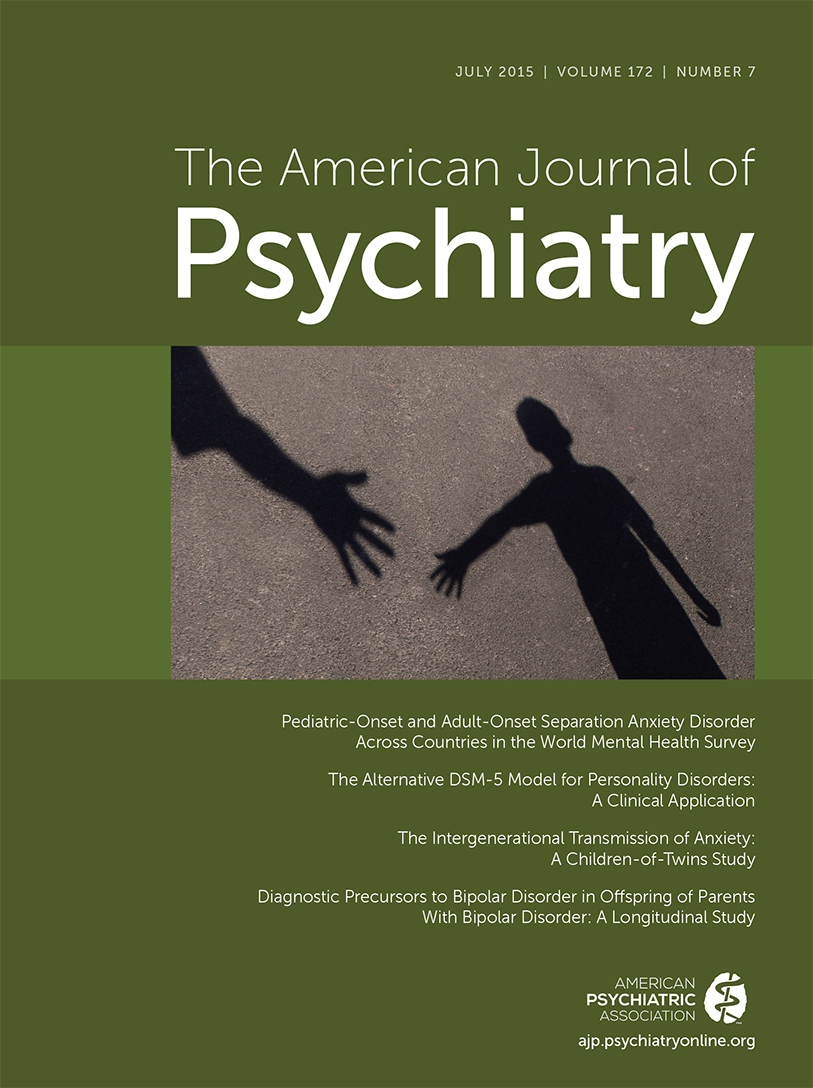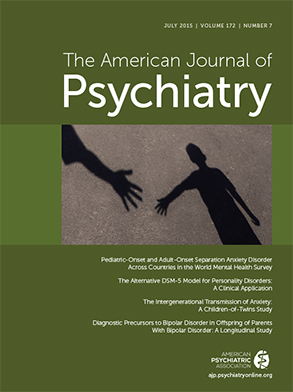“The past is a distant, receding coastline, and we are all in the same boat … If the boat is becalmed, one of the telescopes will be in continual use; it will seem to tell the whole, the unchanging truth. But this is an illusion.” —Julian Barnes, Flaubert’s Parrot (p. 101)
The study by Derrick Silove, M.D., Ph.D., et al. (
1), in this issue of the
Journal, on pediatric- and adult-onset separation anxiety disorder across countries in the World Mental Health Survey, an epidemiologic report of separation anxiety disorder in a sample of 38,993 adults in 18 countries, is an eye-opening study that will contribute to a better appreciation of anxiety disorders across the lifespan. Methods in this extraordinary study are clearly articulated and exemplary. The data reported are divided sensibly by income of country.
The most arresting finding is that 43% of patients with separation anxiety disorder report adult onset. As the DSM diagnostic system has only just acknowledged the presence of separation anxiety disorder in adulthood (
2), this study highlights a very recent and persistent oversight in our understanding of adult anxiety. Another important finding is that separation anxiety disorder prevalence rates vary more widely across countries than do those of other psychiatric disorders. This observation bears consideration, likely hinting at varying definitions of what it means to be so overly anxiously attached as to warrant the label of “illness” across cultures and the economic spectrum, as the authors note. Surprisingly, the prevalence found in the U.S. general population by Silove et al.’s epidemiological survey is 9.2%, second highest in the world after Colombia. Are clinicians aware of rates of separation anxiety disorder of this magnitude in their patients? I doubt it (
3).
The effects of separation anxiety disorder and directionality of psychiatric comorbidities are noteworthy. Previous observations are here borne out: that separation anxiety is a common precursor to other anxiety disorders, particularly panic disorder and agoraphobia (
4), and that anxious attachments may constitute a vulnerability for development of posttraumatic stress disorder (PTSD) in the presence of severe stressors (
5). In this study, looking at time-lagged associations (odds ratios) between onset of separation anxiety disorder and other psychiatric disorders, presence of separation anxiety disorder elevates the odds ratios of developing other mood and anxiety disorders, yet presence of major depression, bipolar disorder, and other anxiety disorders presages development of separation anxiety disorder as well. Notably, Separation anxiety disorder elevates the odds ratios of developing attention deficit hyperactivity disorder and PTSD in nonreciprocal relationships. Risks for development of separation anxiety disorder include childhood adversity and “maladaptive family functioning in childhood” (both of which have increasing cumulative risks for development of separation anxiety disorder), as well as lifetime traumatic exposure: parsed here as war, violence, sexual violence, family death, “network events,” and “other.” Another article featured in this issue of the
Journal, by Thalia C. Eley, Ph.D., et al. (
6), on genetic study of anxiety transmission, highlights the central role of environmental contributions to development of anxiety between generations, looking at a widely divergent domain: a twin-study genetic data set.
Severe role impairment resulting from separation anxiety disorder is worst in high-income countries, where it is nonignorable (71% severe role impairment among adolescents in the presence of psychiatric comorbidity). Yet meaningful role impairment from separation anxiety disorder occurs across age groups and income categories, with or without comorbidity.
What are the Implications?
Separation anxiety disorder is uniquely positioned in its “new” age-span status in the DSM. It is the only disorder formerly thought to affect mostly children and adolescents; now suddenly it has been recognized to affect everyone. A conundrum for the field to consider: why, considering these documented high prevalence rates and the recognition that separation anxiety disorder is a risk factor for common mental disorders (
4), has it been so ignored, relegated to children, perhaps even seen as a childish problem? There are no simple, reductive answers to this perplexing question, but I venture two partial responses.
1.
Separation anxiety disorder comprises a dysregulation that occurs by definition in a dyadic context, more than other anxiety or mood disorders. Affected individuals struggle with complicated, ambivalent attachments, and separation from close attachment figures feels unsafe (
5,
7). The presence of separation anxiety disorder forms an often imperceptible backdrop to close relationships in affected individuals, and because separation anxiety disorder clusters in families it can be relatively culturally syntonic (note the wide range of prevalence), tolerated as an accepted, albeit uncomfortable, aspect to close attachment relationships (
5). This has clinical importance, since patients with separation anxiety disorder may not view this syndrome as having primary pathological importance, yet it clearly contributes to overall burden of psychopathology and imparts debilitating role impairment. Additionally, problems of separation anxiety are viewed by patients as being inherently embarrassing and childish; people feel unable to function by themselves without experiencing anxiety. Particularly before the backdrop of the Western ethos of self-reliance (
7), this syndrome can impart a sense of personal failure. Our nosology may have avoided—over decades of nosological focus on classification—what so many of our patients find humiliating, childish, and undermining of their sense of autonomy and competence. We have all collectively looked away and cannot afford to continue to do so.
2.
To complicate matters, some degree of separation anxiety and anxious attachment is normal in early childhood, imparting an evolutionary advantage to weak or ill members of the species who cannot fend for themselves (
5,
8,
9). This singularly places separation anxiety disorder in a close relationship to individual survival, unlike the dominant anxiety fantasy/avoidance structures associated with most specific syndromes of other anxiety disorders. The infant-caretaker relationship has a profound and life-long impact on patterns of attachment quality, quality of relationships, and life-long mental health (
8,
9). Overwhelming disruptions in the quality of these attachments, as often occurs during episodes of profound psychosocial stress, as operationalized in this study, can create and maintain patterns of anxious attachment between infant and caretaker/mother, not only in humans but in other mammals, from primates (
5,
10) to rodents (
11).
The study findings raise a central question: what actually is adult-onset separation anxiety disorder, as it appears in an epidemiological study like this? Separation anxiety disorder generally occurs in the developmental context of dysregulated attachment relationships, and attachment status develops in the context of early parenting relationships (
8,
9). What factors could so alter, or appear to alter, attachment status to make previously secure attachment relationships feel newly fragile and ambivalent in adulthood? This study reinforces the already understood relationship between the effects of severe trauma and development of dysregulated attachment status (
12). An alternative formulation: can traumas occur in adulthood of sufficient severity to destabilize seemingly secure attachment, suggesting that this phenomenon could be less trait than state? However, other processes may also provide partial explanations. Perhaps losing key attachment figures to whom one is anxiously attached in adulthood may suddenly provoke symptomatic separation anxiety disorder, particularly in circumstances in which close attachment figures tolerate or even reinforce anxiety about separations. In other words, perhaps later life losses can destabilize a key sense of safety, particularly if that sense of safety depends on the presence of an attachment figure, thereby uncovering a pre-existing but subsymptomatic separation anxiety disorder.
Based on these very significant findings regarding prevalence and risk of separation anxiety disorder, and the association between separation anxiety and nonresponse across mood and anxiety disorders (
5), the authors appropriately urge development of specific treatment approaches. This seems a matter of urgent public health importance.

